List of Contents
Fire Stopping Materials Market Size and Forecast 2025 to 2034
The global fire stopping materials market size was valued at USD 1.81 billion in 2024, and is anticipated to hit around USD 1.98 billion by 2025, and is projected to reach around USD 4.38 billion by 2034, at a CAGR of 9.22% from 2025 to 2034. The North America fire stopping materials market size reached USD 580 million in 2023. Stringent safety regulations and growing demand for fire protection across industrial and commercial sectors drive the fire stopping materials market.
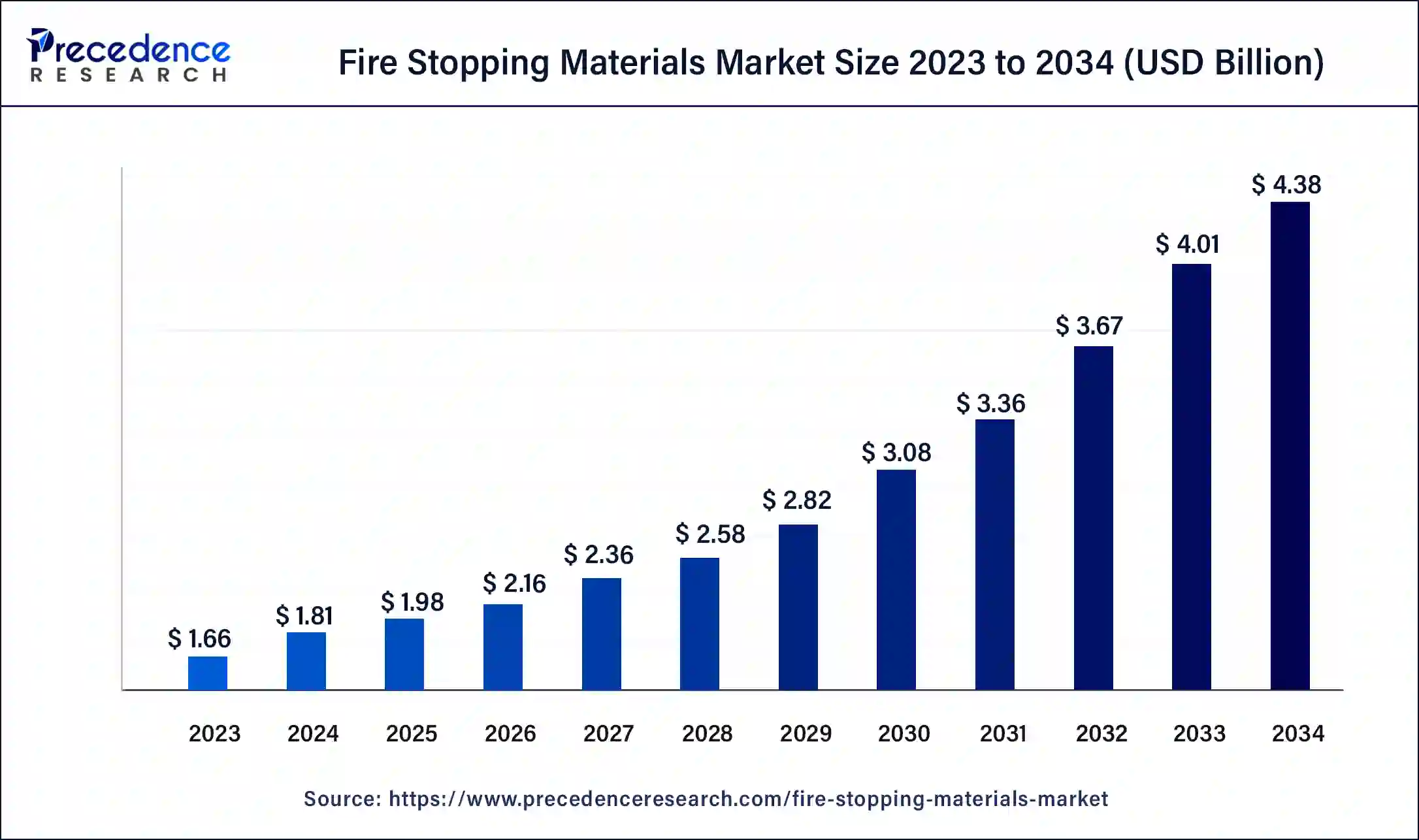
Fire Stopping Materials Market Key Takeaways
- In terms of revenue, the market is valued at $1.98 billion in 2025.
- It is projected to reach $4.38 billion by 2034.
- The market is expected to grow at a CAGR of 9.22% from 2025 to 2034.
- North America dominated the fire stopping materials market with the largest market share of 35% in 2024.
- Asia Pacific is expected to grow at the fastest rate in the market during the forecast period.
- By type, the sealants segment held the dominating share of the market in 2024.
- By type, the putty & putty pads segment is expected to grow at a notable rate in the market during the forecast period.
- By application, the electrical segment accounted for the biggest share of the market in 2024.
- By application, the plumbing segment is expected to witness considerable growth in the market over the forecast period.
- By end user, the commercial segment held the largest share of the market in 2024.
- By end user, the industry segment is expected to grow at the fastest rate in the market during the forecast period.
AI Integration in the Fire Stopping Materials Market
In the fire stopping materials market, the integration of artificial intelligence and IoT technology changes fire safety management. IoT-empowered fire-stopping arrangements work with continuous observing and controller, working on functional productivity and reaction times. Smart detectors with advanced sensors can rapidly identify irregularities like smoke, intensity, or gas, reducing false alarms. AI-driven analysis of information designs upgrades the capacity to predict fire dangers and implement proactive measures. Computerized checking systems further develop fire-stopping maintenance by giving immediate insights into the condition and execution of fire-stop establishments, allowing for early issue detection and advancing the adequacy of fire assurance systems.
- In March 2022, GIWUS Technology, LLC introduced the world's first completely automated AI-controlled fire safety system. This system features the Ultraxs Robotic Firefighter and a Smart Application, effortlessly integrating with existing fire suppression systems and the metaverse. It autonomously detects and controls fires within 55 seconds, eliminating the need for human intervention.
U.S. Fire Stopping Materials Market Size and Growth 2025 to 2034
The U.S. fire stopping materials market size was exhibited at USD 480 million in 2024 and is projected to be worth around USD 1,170 million by 2034, poised to grow at a CAGR of 9.29% from 2025 to 2034.
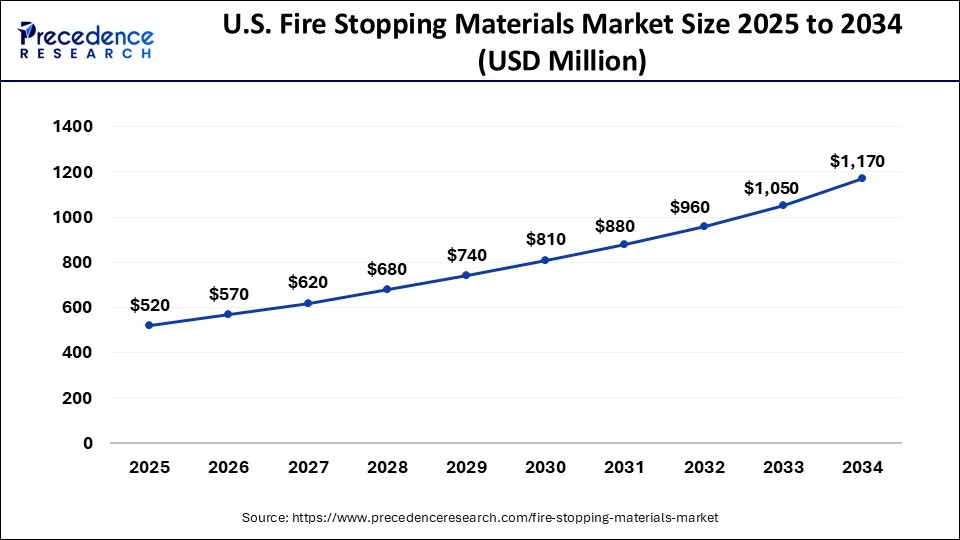
North America accounted for the largest market share of 35% in 2024. Factors such as economic growth, urbanization, and government policies significantly influence construction rates. Economic expansion often stimulates construction activity, while urban development in major cities increases demand for new projects. Additionally, trends in the housing market, advancements in technology, and a focus on sustainability also influence construction rates.
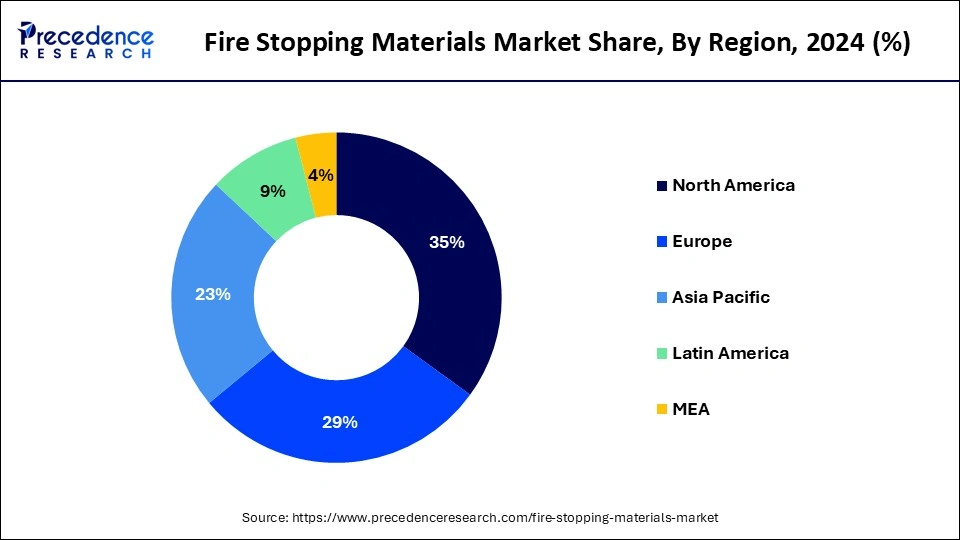
In the U.S. specifically, the increase in fire incidents is driving market growth. The rising frequency of fires in residential, commercial, and industrial sectors is leading to greater emphasis on effective fire protection measures to enhance safety and reduce damage. Also, the rise in construction spending is likely to impact the fire stopping materials market.
- According to the U.S. Census Bureau, the United States spent USD 1,809.8 billion on construction-related costs in December 2022. This represents a 7.7% increase from December 2021, when expenditures totaled USD 1,681.0 billion.
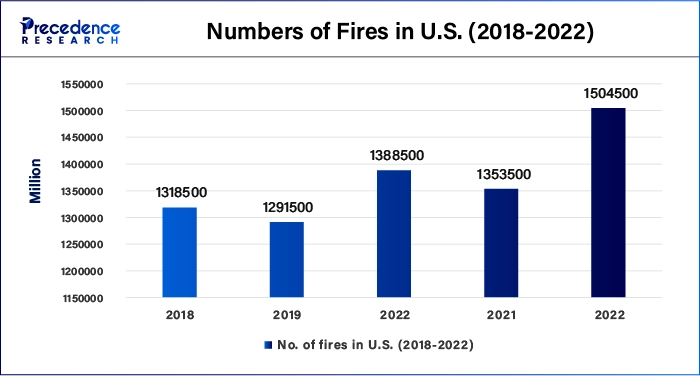
Asia Pacific is expected to grow at the fastest rate in the fire stopping materials market during the forecast period. This expansion is driven by increased construction activities, rapid urbanization, and stringent fire safety regulations. Major players in the region include China, India, Japan, and South Korea. The Growing emphasis on building safety standards and regulatory compliance is fueling demand for advanced fire stopping solutions. Furthermore, the expansion of both commercial and residential infrastructure is further boosting market growth.
- The Indian Brand Equity Foundation (IBEF) reported that USD 2.77 billion was invested in the real estate sector in India during the second quarter of 2024.
- In June 2024, GlobalData reported that the Chinese construction industry is expected to grow by 4% in real terms in 2024, driven by investment in infrastructure and energy projects.
Market Overview
Fire-stopping materials are crucial components for fire protection systems installed in buildings. Their primary goal is to stop the fire blaze and smoke passing through walls, floors, and roofs. There are a variety of fire-stopping materials that can be used for a variety of purposes and requirements. These materials are important to building safety, adding to passive fire protection by safeguarding the respectability of fire-evaluated compartments and barriers. Fire-stopping products are utilized to re-establish the fire resistance ratings of walls and floors, successfully fixing openings made for mechanical, electrical, and plumbing systems. Their essential capability is to upgrade safety by giving additional time for escape during a fire and reducing property damage.
The fire stopping materials market is growing promptly, driven by its vital role in meeting safety standards and regulations across various industrial and commercial sectors. This growth is driven by their critical applications in defending assets, machinery, and infrastructure from fire hazards as the demand for fire safety solutions in high-rise buildings and various industrial sectors rises.
Technological Advancement
Technological advancements in the fire-stopping materials market feature rigorous testing and fire-resistant coatings. The rigorous testing enhances and improves the materials' properties by evaluating them according to rigorous testing protocols. It estimates smoke development and fire resistance. The enhancement and customization of paints for coatings is an advancement in this market. The materials and their nature further segregate into specific applications such as EV batteries. The supporting materials to EV batteries cover factors like encapsulants, coating, ceramics, and mica.
The advanced materials enhance innovation in the fire-stopping materials market. The nano-engineered materials facilitate fire-resistant operation at the molecular level. Intumescent coatings are primarily used in thermal industries. These technologies improve material performance and ensure safety by utilizing suitable and sustainable materials. The advancements in the market bolster reliability and development.
Fire Stopping Materials Market Growth Factors
- Increased regulatory requirements for fire safety in buildings.
- Increased construction rates in residential, commercial, and industrial sectors increase fuel the need for effective fire stopping material.
- Innovation in fire-stooping material improves effectiveness and raises demand for the fire stopping materials market.
Market Scope
| Report Coverage | Details |
| Market Size by 2034 | USD 4.38 Billion |
| Market Size in 2025 | USD 1.98 Billion |
| Market Size in 2024 | USD 1.81 Billion |
| Market Growth Rate from 2025 to 2034 | CAGR of 9.22% |
| Largest Market | North America |
| Base Year | 2024 |
| Forecast Period | 2025 to 2034 |
| Segments Covered | Type, Application, End-user, and Regions |
| Regions Covered | North America, Europe, Asia-Pacific, Latin America, and Middle East & Africa |
Market Dynamics
Drivers
Increasing occurrences of fire accidents
Materials that prevent fire play a crucial role in enhancing building safety. These materials are intended to seal holes and openings in walls, floors, and roofs that could somehow or another permit fire and smoke to spread. By maintaining the integrity of fire-evaluated boundaries, fire-stopping materials help to hold fire inside a particular region, giving an important chance for occupants to get away and for crisis administrations to answer. They likewise limit property harm by preventing the quick spread of flames and poisonous gases. Fire-stopping materials are fundamental for viable fire protection, particularly as fire mishaps become more frequent. Such factors are driving the fire stopping materials market.
- According to the National Crime Records Bureau, fire causes approximately 60 deaths per day in India. In India, fires and other related events account for approximately 25,000 deaths annually.
- The National Fire Protection Association (NFPA) estimated that in 2022, local fire departments across the U.S. responded to approximately 1,504,500 fires. These incidents resulted in around 3,790 civilian deaths, 13,250 injuries, and $18 billion in direct property damage.
- On average, a fire department responds to a fire somewhere in the U.S. every 21 seconds. During the same year, a home structure fire was reported every 88 seconds, a home fire death occurred every three hours and fourteen minutes, and a home fire injury happened every 53 minutes.
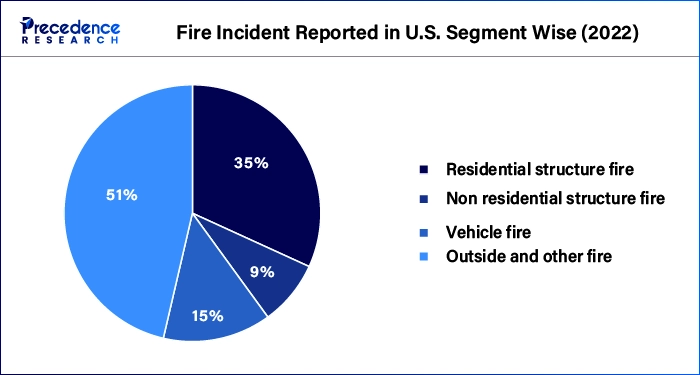
Strengthening fire safety regulations
Strengthening fire safety regulations is a basic driver in upgrading overall building safety. All buildings, particularly high-risk ones like hospitals, schools, and high-rises, should be subject to mandatory, ongoing fire safety audits and inspections. These audits should ensure compliance with fire safety codes, identify potential hazards, and recommend necessary corrective actions, with penalties for non-compliance. Furthermore, updating fire safety infrastructure and equipment is fundamental, including modernizing fire administrations and guaranteeing sufficient fire stations, vehicles, and hardware.
Fire safety regulations are different all over the world because of different national priorities and approaches. For example, the U.S. sticks to norms set by the Public Fire Assurance Affiliation (NFPA), the Global Construction Law (IBC), and OSHA. The United Kingdom's regulations are governed by the Building Regulations and the Regulatory Reform (Fire Safety) Order. The European Union follows the EU Construction Products Regulation (CPR) and European Norms (EN), while Canada conforms to the National Building Code of Canada (NBC), and China involves the Code for Fire Protection Design of Buildings. These regulations play a crucial role in developing fire safety and protecting lives and property.
Restraint
High cost
High costs associated with fire-stopping materials can significantly impact their adoption and market growth. Advanced fire-stopping systems and high-quality fire-stopping material can be costly. The ongoing costs for maintaining and inspecting fire-stopping systems also contribute to their high cost.
- As per the National Fire Protection Association, International Building Code, and International Fire Code maintaining compliance with fire safety standards requires regular inspections and potential repairs, adding to the overall expense.
Opportunity
Advances in innovative fire-stopping systems
Recent advancements in fire-stopping systems have created lucrative opportunities for key players in the fire stopping materials market. The advancement of innovative fire-resistant materials has expanded the scope of fire-stopping arrangements. Present-day improvements incorporate high-level fire-evaluated gypsum sheets, insulation materials, and fire-resistant fabrics and coatings, which give superior fire protection while safeguarding aesthetic and functional qualities. These materials improve building design by integrating enhanced safety highlights with design flexibility.
For example, nanotechnology-based coatings offer extraordinary fire retardancy, and eco-friendly options support sustainability without compromising safety standards. Architects and engineers can improve a building's structural integrity, stop fires from spreading, and make communities more resilient by using cutting-edge materials in construction. This will ultimately reduce the damage caused by fires.
- GrafGuard expandable graphite is an advanced intumescent material that is well-known for its high performance, environmental friendliness, and cost-effectiveness.
Type Insights
The sealants segment held the dominating share of the fire stopping materials market in 2024. Fire sealants and gap fillers are significant for preventing the spread of fire and smoke through openings in buildings. When presented with high temperatures, these fire-stopping materials extend to form a protective barrier. Depending on the substrate and the specific application, selecting the appropriate sealant or filler is crucial.
Chemicals in intumescent sealants, which are frequently utilized in fire-rated walls and floors around pipes, cables, and other penetrations, expand when heated to prevent smoke and fire from entering. Firestop sealants, available in types like silicone, intumescent, and elastomeric, are utilized to fill holes and joints. Silicone sealants are excellent for moist environments due to their flexibility and resistance to water. While elastomeric sealants retain their flexibility and effectiveness in extreme temperatures, intumescent sealants expand significantly when heated, sealing gaps to prevent the passage of smoke and fire.
- The FEICA 2023 European Adhesive and Sealant Conference and EXPO, held at the PortAventura Convention Centre in Tarragona, Spain, from September 13 to 15, 2023, showcased sustainable innovations in the adhesives industry. The event drew nearly 700 delegates.
Tthe putty & putty pads segment is expected to grow at a notable rate in the fire stopping materials market during the forecast period. Firestop putty is a flexible substance that can be molded to fit around pipes, cables, and other small openings in fire-rated walls and floors. It is especially useful in limited spaces where other fire-stopping materials might be difficult to install.
Application Insights
The electrical segment accounted for the biggest share of the fire stopping materials market in 2024. The fire resistance of separating elements can be weakened by ‘partial penetrations, like down-lighters, electrical sockets, switches, and sound systems. Under fire conditions, these fittings might permit heat to enter the holes of walls, segments, floors, or roofs all the more rapidly, possibly leading to premature failure. To resolve these issues, the National Fire Protection Association upholds National Electrical Security Month, a drive by the Electrical Safety Foundation (ESFI) that aims to bring issues to light about home electrical dangers, feature the significance of electrical fire security, and guarantee the safety of electrical workers.
- In February 2022, Recticel Insulation announced that it had obtained the renowned PEFC label for its multilayer thermal insulation solutions, becoming the first PIR/PUR manufacturer authorized to use this environmental label.
The plumbing segment is expected to witness considerable growth in the fire stopping materials market over the forecast period. Fire stopping includes carrying out preventative measures to restrict the spread of fire and smoke all through a building. This means pipes, gaps, and openings in fire-rated walls, floors, and ceilings in the plumbing industry. The objective is to maintain these barriers' fire resistance ratings. Effective fire-stopping arrangements, including smart intumescent products, are critical for preventing the fire from going through the pipework. By slowing the spread of fire and smoke, passive fire and smoke barriers in walls, ceilings, and floors contribute significantly to building safety. Maintaining the fire resistance of the compartment walls and floors, preventing the fire from spreading. Particular fire-stopping items are utilized to seal pipe penetrations, accordingly improving building fire safety.
- In April 2022, GF Piping Systems launched HEAT-FIT at Seatrade Cruise Global in Miami, unveiling a lightweight, corrosion-free, and efficient thermoplastic piping system.
End-user Insights
The commercial segment held the largest share of the fire stopping materials market in 2024. This area incorporates various offices, such as cafes, hospitals, retail and supermarkets, hotels, and institutional buildings like secondary schools and universities. Modern commercial and public structures are continually advancing, which can influence the adequacy of introduced fire assurance frameworks. In particular, building administrations frequently cause breaks in fire obstructions. The development of fire-resistant building materials that are resistant to fire is reshaping construction safety.
The industry segment is expected to grow at the fastest rate in the fire stopping materials market during the forecast period. Fire-stopping materials, including sealants, mortars, and coatings, have become crucial for meeting stringent safety standards and regulations in the construction industry. Their applications extend beyond construction to various sectors such as manufacturing, oil and gas, aerospace, electrical, automotive, and telecommunications. These materials are highly valued for their ability to safeguard critical assets, machinery, and equipment from fire. The adoption of fire stopping materials is rapidly increasing due to their vital role in providing fire safety solutions for high-rise buildings and other structures.
Fire Stopping Materials Markets Companies
- AkzoNobel N.V.
- 3M
- Sika AG
- BASF SE
- Hilti
- Morgan Advanced Materials
- RectorSeal Corporation
- RPM International
- Specified Technologies
Recent Developments
- In June 2024, FSi Promat launched a white paper highlighting the impact dynamic movement can have on the effectiveness of penetration seals and ways to ensure passive fire protection remains compliant for a building's lifetime. (Source - https://internationalfireandsafetyjournal.com)
- In May 2024, a Japanese company developed a wooden “dream material” with outstanding fire resistance that can be processed in the same way as ordinary wood and maintains the warmth of its appearance. (Source - https://www.gov-online.go.jp)
- In June 2022, Hempel launched Hempafire XTR 100, an epoxy intumescent coating designed for hydrocarbon passive fire protection of oil and gas downstream assets. The coating insulates steel during a hydrocarbon pool fire, extending the steel's load-bearing capacity for up to four hours, allowing more time for safe evacuation and protection of valuable assets while fire-fighting teams address the blaze.
- In September 2023, scientists in the United States successfully developed a silicon-based coating to impede fire spread by preventing materials from coming into contact with flames. This coating reduces combustion at the molecular level.
- In February 2022, Australian and Chinese researchers created an innovative flame-retardant coating inspired by lava. When applied to materials like foam insulation, this coating forms a ceramic layer upon exposure to heat, effectively halting flames and providing a cost-effective, nontoxic solution for improved building fire safety.
- In April 2022, Henkel introduced new fire protection solutions for electric vehicle batteries with Loctite FPC 5060 and Loctite EA 9400. These coatings are designed to protect battery packs against fire and heat in the event of a thermal runaway, helping to inhibit and delay the spread of fires, thereby giving passengers more time to evacuate.
Segments Covered in the Report
By Type
- Sealants
- Mortar
- Boards
- Putty & Putty Pads
- Collars
- Wraps/Strips
By Application
- Electrical
- Mechanical
- Plumbing
- Others
By End-user
- Residential
- Commercial
- Industrial Source
By Region
- North America
- Asia Pacific
- Europe
- Latin America
- Middle East & Africa
For inquiries regarding discounts, bulk purchases, or customization requests, please contact us at sales@precedenceresearch.com
Frequently Asked Questions
Ask For Sample
No cookie-cutter, only authentic analysis – take the 1st step to become a Precedence Research client